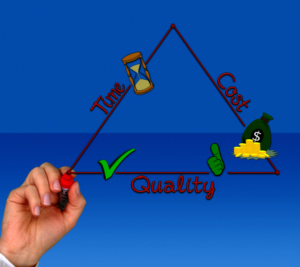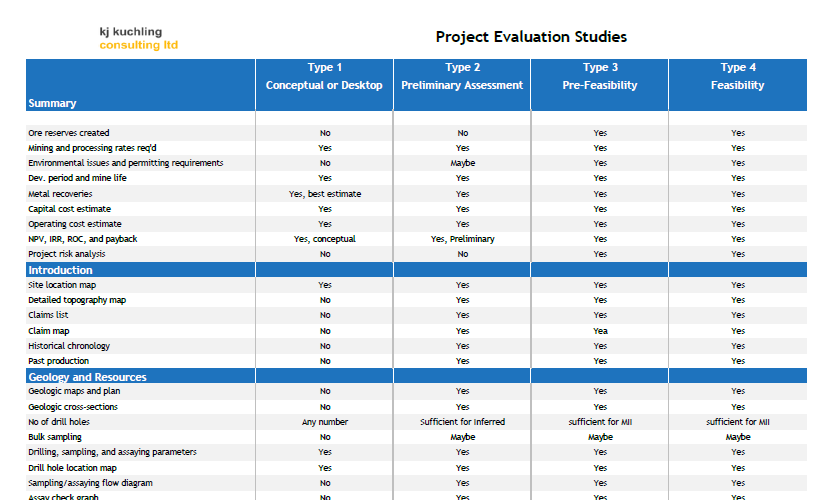
When it comes to time to undertake any type of mining study, whether small or large, whether sole sourced or competitively bid, it is always a good idea to prepare a Request For Proposal (“RFP”) document.
I know that it can be an annoyance, but an RFP document is a lot better than a simply phone calling a consultant describing what you want. Its also better than a cursory email outlining what you want. In many cases the RFP doesn’t need to be a complex document; however RFP’s are appreciated by everyone involved. It provides the documentation that can help make things go smoothly.
The RFP doesn’t need to be complicated
 Owner’s Perspective: preparing an RFP gives the opportunity to collect the Owner’s team thoughts on the scope of study needed, on the deliverables required, and on the timing. The RFP will outline this for the consultants and simultaneously help the owner’s team to get on the same page themselves.
Owner’s Perspective: preparing an RFP gives the opportunity to collect the Owner’s team thoughts on the scope of study needed, on the deliverables required, and on the timing. The RFP will outline this for the consultants and simultaneously help the owner’s team to get on the same page themselves.
The RFP is the opportunity for the owner to tell the consultants exactly what they are looking for in the mining study. It also specifies what they want to see in the proposal to help them compare multiple proposals if needed.
Consultant’s perspective: receiving an RFP is great to them since having a detailed scope of work laid out means they don’t need to guess the scope when preparing their cost estimate. It will be clear to the consultant what work is “in scope”. If extra services are required in the future, then “out-of-scope” work can be defended.
An RFP also gives the consultant some reassurance that the Owner has put thought into exactly what they want them to do.
What to include in the RFP
 The RFP sent to bidding consultants should contain (at a minimum) the items listed below. A sole sourced study can have a scaled back RFP document, but many of these key items should be maintained.
The RFP sent to bidding consultants should contain (at a minimum) the items listed below. A sole sourced study can have a scaled back RFP document, but many of these key items should be maintained.
Much of this RFP information can be a single template document that will be modified if different scopes of work will be sent to different consultants (e.g. tailings design, pit geotechnical, groundwater, feasibility study, etc.).
-
Project Introduction (a high level overview of the project and the Owner).
-
Table of Responsibilities for the Study (if other consultants are being involved in different areas).
-
Scope of Work (for this Proposal), and highlight any specific exclusions from the scope.
-
Additional Requirements (update meetings, monthly reports, timesheets, documentation, etc.)
-
Schedule (the timing for the proposal, job award date, study kickoff, and completion date).
-
Instructions to the Bidder (e.g. what information should be provided in each proposal and in what format).
-
Other (the legal rights of the Owner, confidentiality statement, how proposals will be evaluated, etc.).
Specifying format makes it easier to compare proposals
 If a company is competitively bidding the study, it can be easier to compare multiple proposals if certain parts are presented in the exact same format. Usually different consulting firms have their own proposal format, which is fine, however certain sections of the proposal should be made easily comparable.
If a company is competitively bidding the study, it can be easier to compare multiple proposals if certain parts are presented in the exact same format. Usually different consulting firms have their own proposal format, which is fine, however certain sections of the proposal should be made easily comparable.
The RFP can request that each proposal should contain (at a minimum):
-
Confirmation of the scope of work based on the RFP, which may be more detailed than the RFP itself.
-
List of exclusions.
-
List of final deliverables.
-
Proposed Study Manager, resume and relevant study management experience.
-
Proposed team members, organizational structure by areas of responsibility, and resumes.
-
Cost estimate on a not-to-exceed basis for each area, subdivided by team member, hours and unit rates ,and possibly in a specific table format.
-
A fee table for the various job classifications that would be applied to out-of-scope additional man hours.
-
All indirect costs, administrative costs, indicating mark-ups (if any).
-
Miscellaneous disbursements (i.e., airfares, hotel, vehicles) and indicate if there are mark-ups.
-
Detailed study schedule to completion.
-
Payment schedule.
-
Specify if there are any potential conflicts of interest with other projects.
Conclusion
 The bottom line is that an owner should always take the time to prepare some type of RFP for any mining study they want to undertake. The owner should also request a consultant proposal based on that RFP, even if it is being sole sourced to just one consultant.
The bottom line is that an owner should always take the time to prepare some type of RFP for any mining study they want to undertake. The owner should also request a consultant proposal based on that RFP, even if it is being sole sourced to just one consultant.
Depending on the size and nature of the study, one can use judgement on how detailed the RFP or consultant’s proposal must be, but one should always have the proper documentation in place beforehand.
A key part of any mining study is the project capital cost estimate. In my view it is important that any RFP includes the requirement to develop a Work Breakdown Structure. This has many uses, and is discussed further in the blog post “Work Breakdown Structures – Don’t Forget About The WBS“
My entire blog post library can be found at this LINK with topics ranging from geotechnical, financial modelling, and junior mining investing.



 In my personal experience I find that larger consultants are best suited for managing the large scale feasibility studies. This isn’t because they necessarily provide better technical expertise. Its because they generally have the internal project management and costing systems to manage the complexities of such larger studies.
In my personal experience I find that larger consultants are best suited for managing the large scale feasibility studies. This isn’t because they necessarily provide better technical expertise. Its because they generally have the internal project management and costing systems to manage the complexities of such larger studies. For certain aspects of a feasibility study, one may get better technical expertise by subcontracting to smaller highly specialized engineering firms. However too much subcontracting may become an onerous task. Often the larger firms may be better positioned to do this.
For certain aspects of a feasibility study, one may get better technical expertise by subcontracting to smaller highly specialized engineering firms. However too much subcontracting may become an onerous task. Often the larger firms may be better positioned to do this. One of the purposes of an early stage study is to see if the project has economic merit and would therefore warrant further expenditures in the future. An early stage study is (hopefully) not used to defend a production decision. The objective of an early stage study is not necessarily to terminate a project (unless it is obviously highly uneconomic).
One of the purposes of an early stage study is to see if the project has economic merit and would therefore warrant further expenditures in the future. An early stage study is (hopefully) not used to defend a production decision. The objective of an early stage study is not necessarily to terminate a project (unless it is obviously highly uneconomic).
 My recollection is that many years ago larger consulting firms would offer to do an entire study in-house. They would have the in-house team to cover almost the entire study. That approach seems to have changed and now the multi-company path is the norm.
My recollection is that many years ago larger consulting firms would offer to do an entire study in-house. They would have the in-house team to cover almost the entire study. That approach seems to have changed and now the multi-company path is the norm. The Study Manager must ensure that everyone understands what their deliverables are. Generally this is done using a “Responsibility Matrix”, but these can sometimes be too general.
The Study Manager must ensure that everyone understands what their deliverables are. Generally this is done using a “Responsibility Matrix”, but these can sometimes be too general.


 Some of the models I have reviewed will build the entire operating cost (mining, processing, G&A) in one grand file. They will build in the capital cost too and finally provide the economic model… all in one spreadsheet!
Some of the models I have reviewed will build the entire operating cost (mining, processing, G&A) in one grand file. They will build in the capital cost too and finally provide the economic model… all in one spreadsheet!